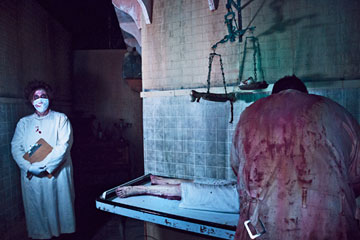
Not scared at the Headless Horseman in Ulster Park, N.Y.? You may already be undead.
(2 of 2)
The links between Hollywood and the haunted-house industry are particularly extensive--film trends lead haunt trends--and given the current zombie zeitgeist, blood and guts are on moviegoers' menus. "As our culture gets more sexualized and more violent, you see it in Halloween, which is basically an expressive holiday, or in haunted houses," says Lesley Bannatyne, author of Halloween Nation. "It's not red lights and buzzers anymore. It's a lot of blood."
Ghost shows date back centuries, and American trick-or-treating traditions were commercialized in the post--World War II suburbs, but the hardcore Halloween of today is only decades old. David J. Skal, author of Death Makes a Holiday: A Cultural History of Halloween, says that in the 1970s, urban legends and scattered reports of Halloween violence made the holiday more ominous, a time when it wasn't safe to be on the streets. Meanwhile, popular culture ramped up the fear factor. Between the 1969 opening of the tame-for-today Haunted Mansion at Disneyland, the grandfather of the commercial haunt, and John Carpenter's 1978 shockfest, Halloween, the decade started putting forth new visions of Halloween-adjacent horror, driving the growth of pay-to-enter haunts.
Now the industry is just old enough for fans to be hardened too. "When I started out, we were able to entertain with rough masks and plastic knives. Twenty-two years later, you cannot do what you did in the past," says Patrick Konopelski, who runs Shocktoberfest, near Reading, Pa., and is president of the HAA. "It's our job to deliver every year a bigger, badder and better scare."
One idea that Konopelski hoped to try out this year was a haunted-house tour that visitors would enter naked (to make them feel more vulnerable, he says). Objections from local municipalities persuaded him to dial back to an underwear tour. A less controversial solution is the turn to technology. At haunted houses all across the U.S., silicone masks that closely resemble skin and can cost hundreds of dollars have largely replaced latex ones; projectors create walls crawling with bugs; flat screens make haunted windows; fog and lights create a swampy miasma; hidden laser beams--tripped by visitors as they pass--trigger the action. An animatronic monster with a live actor, usually inside, is called a shocktronic. For $3,770, a company called the Horror Dome will sell you one--a robotic Huge Zombie Mom that births a human being in a "bloody flesh leotard and baby mask." Last year haunt producer Steve Kopelman tried a new idea at his Phoenix location. Visitors were tracked with radio-frequency identification tags, and if they granted access to their Facebook pages, photos of their friends would appear on the walls as they made their way through the house. "It's really creepy," he (unnecessarily) explains.
There's a macabre industry refrain, Shocktoberfest's Konopelski says, that sums up its shock-inflation problem: The only way to satisfy customers would be to cut off their arms and slap them upside the head with them.
On the other hand, so to speak, sometimes a scare takes no effort at all--even when the victim is a seasoned haunter like Michael Jubie. "When you work in the corn maze, if the wind is blowing just right, you don't even have to have people out there," he says. "You get a startle just from the corn."
